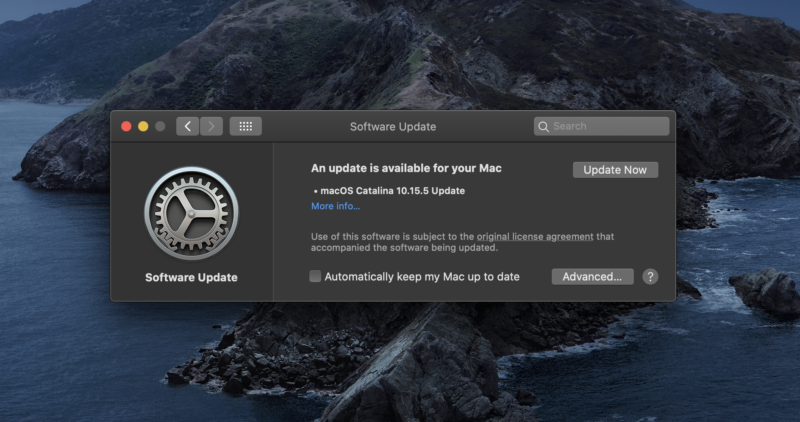
This week, Apple released macOS Catalina 10.15.5, rounding out a series of system software updates that has rolled out to various Apple platforms (iOS, iPadOS, watchOS, tvOS) over the course of a week or so.
This version of macOS is primarily focused on a new battery management feature similar to one already introduced in iOS. It helps prolong the life of the device's physical battery by moderating charging based on users' habits.With "Battery Health Management" in macOS 10.15.5, Apple aims to increase the life of the lithium-ion battery in each MacBook by limiting that laptop's maximum charge level when plugged in based on analysis of your charging patterns and the battery's temperature history. Charging to full unnecessarily can reduce the number of cycles before a lithium-ion battery becomes less reliable.
In a support page on the feature, Apple explains:
Based on the measurements that it collects, battery health management may reduce your battery's maximum charge when in this mode. This happens as needed to ensure that your battery charges to a level that's optimized for your usage—reducing wear on the battery, and slowing its chemical aging.
The company goes on to note that while this can increase the longterm viability of your laptop's battery, it can obviously reduce how much time you can use the laptop between charges. The feature tries to tailor itself to fit how long you tend to be unplugged, but there's some variance there.
To that end, you can turn off the feature in the System Preferences panel in macOS. Also, the device's battery health is now reported in the Energy Saver section of System Preferences.
-
To disable the new battery management feature, go to the Energy Saver panel in System Preferences, click "Battery Health," uncheck "Battery Health Management," and click OK.
-
This will lead to a confirmation dialogue. Just click "turn off" to confirm your choice.
There are only two other features listed in the macOS 10.15.5 release notes. One is special new controls for calibrating and tuning Apple's Pro Display XDR monitor, and the other is the ability to disable "automatic prominence" in Group FaceTime calls—that is, to prevent video tiles from changing size based on who is speaking at a given moment.
Beyond that, 10.15.5 is about bug fixes, including one that prevented a T2 chip-equipped machine's internal speakers from appearing as a sound output device, as well as a "stability issue when transferring large amounts of data to RAID volumes," among other things.The update is available now to all Macs that are supported by last year's Catalina update. Apple is expected to unveil the successor to macOS Catalina at its virtual developer conference in late June.
Apple’s macOS Catalina 10.15.5 release notes
macOS Catalina 10.15.5 introduces battery health management in the Energy Saver settings for notebooks, an option to control automatic prominence of video tiles on Group FaceTime calls, and controls to fine-tune the built-in calibration of your Pro Display XDR. The update also improves the stability, reliability, and security of your Mac.
Battery health management
- Battery health management to help maximize battery lifespan for Mac notebooks
- Energy Saver preference pane now displays battery condition and recommends if the battery needs to be serviced
- Option to disable battery health management
- For more information, please visit https://support.apple.com/kb/HT211094
FaceTime prominence preference
- Option to control automatic prominence on Group FaceTime calls so video tiles do not change size when a participant speaks
Calibration fine-tuning for Pro Display XDR
- Controls to fine-tune the built-in calibration of your Pro Display XDR by adjusting the white point and luminance for a precise match to your own display calibration target
This update also includes bug fixes and other improvements.
- Fixes an issue that may prevent Reminders from sending notifications for recurring reminders
- Addresses an issue that may prevent password entry on the login screen
- Fixes an issue where System Preferences would continue to show a notification badge even after installing an update
- Resolves an issue where the built-in camera may not be detected when trying to use it after using a video conferencing app
- Addresses an issue for Mac computers with the Apple T2 Security Chip where internal speakers may not appear as a sound output device in Sound preferences
- Fixes a stability issue with uploading and downloading media files from iCloud Photo Library while your Mac is asleep
- Resolves a stability issue when transferring large amounts of data to RAID volumes
- Fixes an issue where the Reduce Motion Accessibility preference did not reduce the speed of animations in a FaceTime group call
Some features may not be available for all regions, or on all Apple devices.
For more detailed information about this update, please visit: https://support.apple.com/kb/HT210642
For detailed information about the security content of this update, please visit: https://support.apple.com/kb/HT201222
reader comments
91